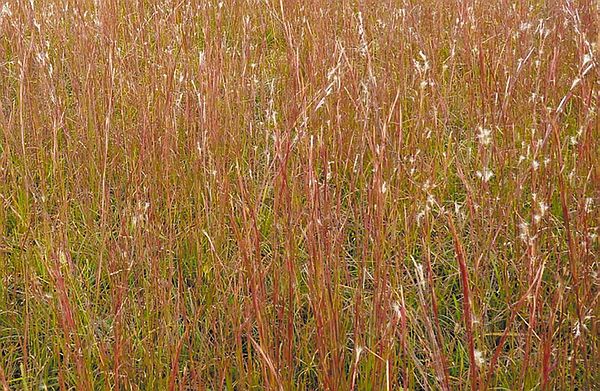by Bobbi Smith, Care NET Community Conservation Committee of TN Sierra Club

Splitbeard Bluestem (Andropogon ternarius), in Rocky Mount Historic Site,
a gorgeous grass, native to the Southeast, that provides food and habitat for countless birds,
butterflies, mammals, etc., even supporting other grasses and wildflowers as they begin to flourish.
Also, notice the panicles of another native grass' seeds, Purpletop (Tridens flavus), dangling in the background.
On Rocky Mount State Historic Site’s 40 acres, visitors will find a flock of authentic Cotswold sheep, a blacksmith shop, and gardens maintained by Master Gardeners. On the grounds, passionate costumed interpreters, educators, museum guides and volunteers share their expertise with guests, who leave with greater knowledge of the history of Northeast Tennessee. And in the state-of-the-art museum are 18th and 19th century artifacts and valuable historical information.
And then there are the acres of pasture--including a spring, a small pond and woodlots--where an exceptional fledgling project aiming to restore native grasses and remove invasive species is unfolding.
Melanie Kelley is charged with re-establishing acres of native grassland at Rocky Mount. For at least the past 60 years these pastures had been mowed and the grass baled. Kelley began walking the fields, looking at dried seed heads for evidence of native species. After walking and watching all last winter, Kelley realized the fields were full of unknown grasses, and very few herbaceous plants.
She contacted specialists from the Department of Biological Sciences and the Pollinator Research Group, both at East Tennessee State University (ETSU), and, “every naturalist I know.” she said. “We all saw the same thing—an incredible and very different ecosystem than other open spaces in Northeast Tennessee.” Kelley requested and received permission for a full-blown restoration of 20-plus acres of native grasslands at Rocky Mount. She then enlisted Cade Campbell, a member of Tri-Cities Young Naturalists (affiliated with the national organization iNaturalists), to help with species identification.

Grassland enthusiast Cade Campbell dragging invasive-exotic Amur Honey- suckle (Lonicera maackii),
an eco- logically destructive species at Rocky Mount, from the open forest bordering the grasslands.
Photo by Don Davis
When the fields were mowed in mid-July of this year, introduced grasses like Fescue and Johnson grass seemed to dominate. It was a seeming disappointment, but as August rolled into September, the warm season grasses began to grow. The orange milkweed known as Butterfly Weed grew and bloomed. Passionflower vines and Southern Slender Ladies’ Tresses popped up in abundance, which brought in the butterflies that use them as host plants. On display was a sea of reddish purple as the Purpletop grass set seed. Deep blue clumps of Bluestem grasses appeared, along with Purple Lovegrass and the milk chocolate stems of Broomsedge. That’s when Dr. Foster (Frosty) Levy, Professor Emeritus in Biological Sciences at ETSU, where he taught Conservation Biology, came out to the site and declared the fields to be some of the purest stands of native grasses he had ever seen in East Tennessee.
Fast forward to October 31. Mel put out an invite to the Tri-Cities Young Naturalists, iNaturalists, and local Sierra Club Conservation Committees including Tri-Cities and Care NET. Several members responded, and met at Rocky Mount on a warm, sunny fall day. Cade led the group through the grasslands, pointing out and identifying a dizzying number of native grasses and other plant species that are now repopulating the meadows, as well as bird species feeding on those grasses and late summer blooms.

Head of Maintenance at Rocky Mount Don Davis (left)
takes a break with Alpha Phi Omega service fraternity/sorority member Jackson Hutchins
during removal of invasive Amur (bush) Honey- suckle from the restoration site.
The following Saturday was a workday headed by Mel and Don Davis, who championed the restoration of the woods and grasslands to restore the 20 acres closer to its 1790s ecology. Don is a Master Gardener and head of maintenance at Rocky Mount. Boots-on-the-ground included students doing a service project for Alpha Phi Omega fraternity/sorority at ETSU; members of Tri-Cities Young Naturalists; iNaturalists; Care NET CCC and Tri-Cities Sierra Clubmembers — around 20 in all. Armed with clippers, loppers, and a lone chainsaw, they cut and dragged a huge quantity of invasive Amur (bush) Honeysuckle from a section of woods to the edge of the road to be hauled away. Time well spent. They can’t wait to see this bit of ‘native prairie and woodland’ come to life again next Spring!
Follow the progress of this restoration project: https://bit.ly/RockyMountRestore.
Contact Bobbi at ardia1952@yahoo.com.